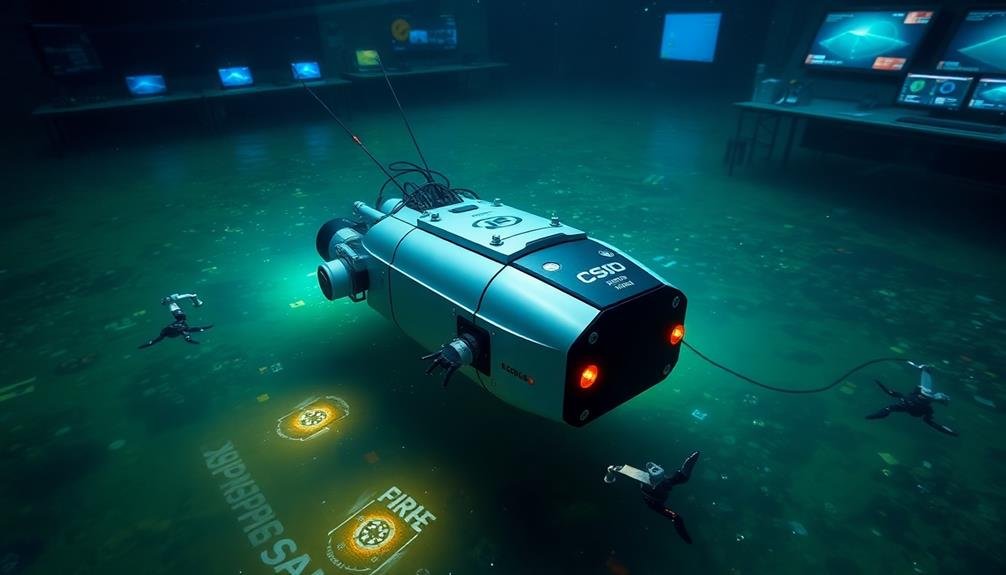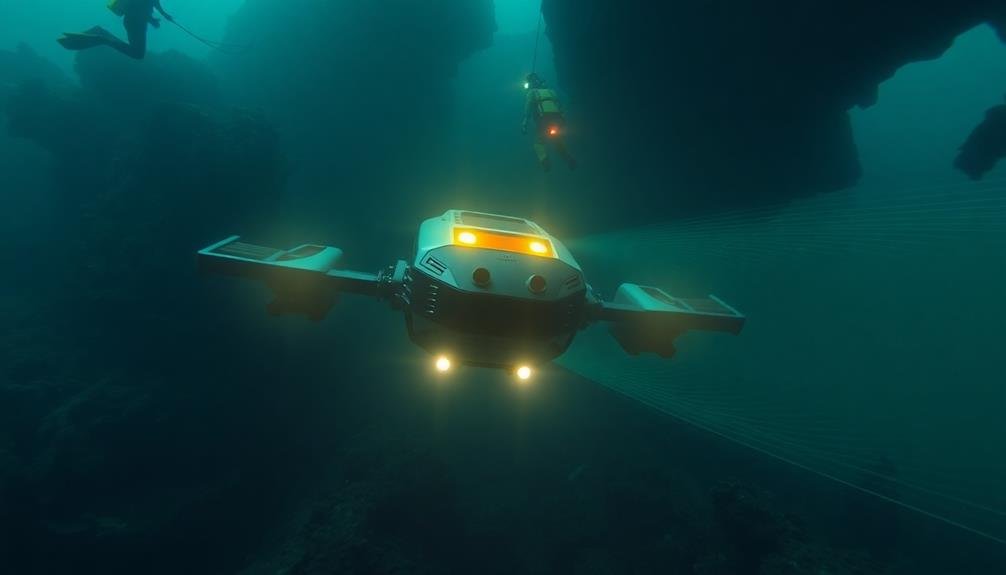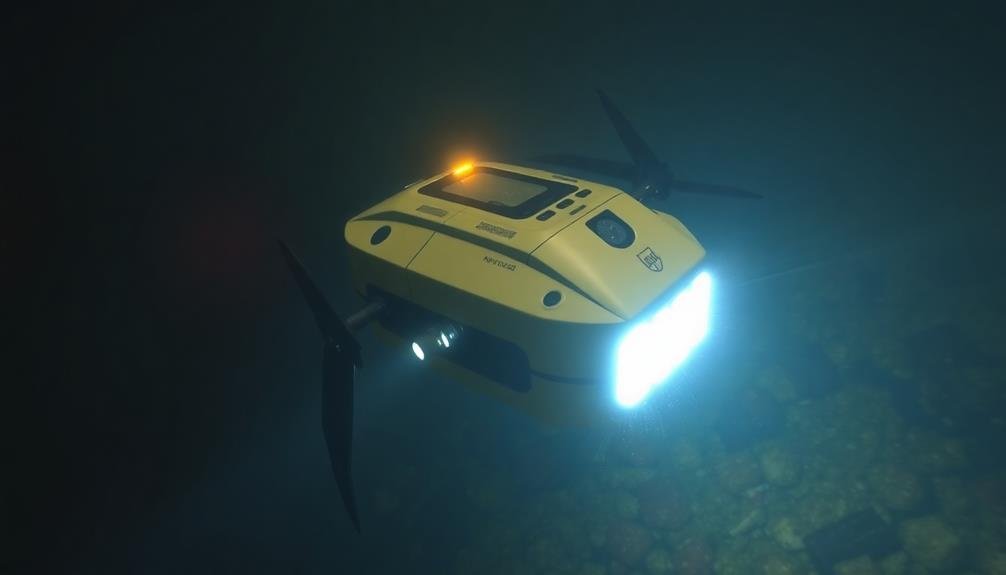Submersible robots are essential for water rescues, offering enhanced underwater visibility and remote operation in hazardous conditions. They can search continuously for extended periods, covering vast areas without fatigue. These robots transmit real-time data, allowing surface teams to make quick decisions. With precise maneuverability, they navigate tight spaces and adapt to various depths, accessing areas too dangerous for human divers. Their advanced sensors detect potential hazards and provide critical information about underwater conditions. By minimizing risks to human life and maximizing search efficiency, submersible robots have become indispensable tools in underwater rescue operations. Discover how these technological marvels are transforming aquatic emergency response.
Enhanced Underwater Visibility

The murky depths of rescue operations become crystal clear with submersible robots' enhanced underwater visibility capabilities. These advanced machines are equipped with high-resolution cameras and powerful LED lights that can penetrate even the darkest waters.
You'll be amazed at how they can illuminate underwater scenes, revealing details that would otherwise remain hidden from human divers.
Submersible robots use sophisticated sonar technology to create detailed 3D maps of the underwater environment. This allows you to navigate treacherous areas with precision, avoiding obstacles and identifying potential hazards.
Some models even employ artificial intelligence to analyze underwater conditions in real-time, adjusting their lighting and camera settings for ideal visibility.
You'll find that these robots can operate in conditions too dangerous for human divers, such as contaminated waters or extreme depths. They're also equipped with thermal imaging cameras, enabling you to detect heat signatures of survivors in low-visibility situations.
With their ability to stream live video feeds to surface teams, submersible robots provide vital real-time information for coordinating rescue efforts and making informed decisions. This enhanced visibility greatly improves the chances of successful water rescues.
Remote Operation in Hazardous Conditions

Hazardous conditions often pose significant risks to human rescue teams, but submersible robots excel in these dangerous environments. You'll find these machines can navigate treacherous waters, contaminated areas, and extreme depths that would be life-threatening for human divers.
With remote operation capabilities, you can control these robots from a safe distance, minimizing the risk to human life. They're equipped with advanced sensors and cameras that transmit real-time data, allowing you to assess the situation and make informed decisions without putting anyone in harm's way.
These submersible robots can operate in various hazardous conditions, including:
- Toxic chemical spills
- Radioactive contamination
- Extreme temperatures
- Strong currents
- Underwater caves and confined spaces
You'll appreciate how these robots can work tirelessly for extended periods, unlike human divers who face limitations due to oxygen supply and physical endurance. They're also immune to decompression sickness, allowing for rapid ascents and descents.
In disaster scenarios, such as sunken ships or flooded mines, you can deploy these robots quickly, potentially saving lives that would otherwise be lost due to delayed human intervention.
Extended Search Duration Capabilities

Tireless persistence characterizes submersible robots' extended search duration capabilities. Unlike human divers who face physical limitations, these robots can operate continuously for extended periods, greatly increasing the chances of successful water rescues.
You'll find that submersible robots offer unparalleled endurance in search operations. They can:
- Operate for days or even weeks without breaks
- Cover vast areas of water bodies systematically
- Maintain consistent performance regardless of time or weather conditions
- Carry out repetitive tasks without fatigue or loss of focus
These robots don't need rest, food, or air, allowing them to search relentlessly in challenging underwater environments. You'll appreciate their ability to work around the clock, maximizing the crucial time window for finding survivors or recovering essential evidence.
Moreover, you can equip these robots with advanced sensors and cameras that don't deteriorate in performance over time. This guarantees consistent data collection throughout the extended search duration.
Real-Time Data Transmission

You'll find that real-time data transmission is essential for effective water rescue operations using submersible robots.
These robots employ high-speed underwater communication systems to relay important information instantly to surface teams.
Through live video feeds and integrated sensor data, you can monitor the rescue situation as it unfolds, allowing for quick decision-making and coordinated efforts.
High-Speed Underwater Communication
Communication is the lifeline of any rescue operation, and underwater scenarios are no exception. High-speed underwater communication is essential for submersible robots to effectively assist in water rescues. These advanced systems allow for real-time data exchange between the robot and surface operators, ensuring swift and accurate decision-making.
You'll find that high-speed underwater communication offers several key advantages:
- Rapid transmission of sensor data, including sonar, video, and environmental information
- Instant relay of victim location and condition to rescue teams
- Real-time control adjustments for precise robot maneuvering
- Immediate alerts for potential hazards or changes in rescue conditions
By utilizing acoustic modems and advanced signal processing techniques, these systems overcome the challenges of underwater signal propagation. They're designed to function in various aquatic environments, from murky rivers to deep ocean waters.
You'll see improved data rates and reduced latency compared to traditional underwater communication methods, allowing for more efficient rescue operations.
With high-speed underwater communication, you're not just improving the capabilities of submersible robots; you're enhancing the overall effectiveness of water rescue missions, potentially saving more lives in critical situations.
Live Video Feed Capabilities
Building on the foundation of high-speed underwater communication, live video feed capabilities represent a game-changing feature for submersible rescue robots.
These advanced systems allow you to see exactly what the robot sees in real-time, providing essential visual information during rescue operations.
With live video feeds, you can assess the underwater situation instantly, identifying potential hazards, locating victims, and guiding the robot's movements with precision. This real-time visual data enables you to make quick, informed decisions that can mean the difference between life and death in critical rescue scenarios.
The clarity and quality of these video feeds have improved dramatically in recent years. You'll now find high-definition cameras that can capture clear images even in murky or low-light conditions.
Some systems even incorporate multiple cameras, giving you a 360-degree view of the underwater environment.
These live feeds can be transmitted to multiple devices simultaneously, allowing rescue teams on boats, shore, or command centers to collaborate effectively.
You can also record the video for later analysis, training, or legal purposes. This technology considerably enhances the effectiveness and efficiency of submersible robots in water rescues.
Sensor Data Integration
How do submersible rescue robots harness the power of multiple sensors to enhance their effectiveness? These advanced machines integrate various sensors to collect and transmit real-time data, providing rescuers with essential information about underwater conditions.
By combining data from multiple sources, rescue teams can make more informed decisions and navigate challenging environments with greater precision.
You'll find that sensor data integration in submersible robots typically includes:
- Sonar systems for mapping underwater terrain and detecting obstacles
- Pressure sensors to monitor depth and guarantee safe operation
- Temperature sensors to assess water conditions and identify potential hazards
- Chemical sensors to detect pollutants or other dangerous substances
This extensive sensor array allows rescuers to build a detailed picture of the underwater environment.
You'll receive real-time updates on water temperature, visibility, and potential dangers, enabling you to adapt your rescue strategy on the fly.
The robots' ability to transmit this data to surface teams creates a crucial link between the underwater environment and rescue coordinators.
Precise Underwater Maneuverability

Submersible rescue robots excel in precise underwater maneuverability, a vital feature for effective water rescues. They're designed to navigate through complex underwater environments, overcoming challenges like strong currents, low visibility, and debris. You'll find these robots equipped with multiple thrusters and advanced control systems, allowing them to move in any direction with remarkable accuracy.
The robots' maneuverability is enhanced by their compact size and streamlined design. They can easily access tight spaces where human divers might struggle, such as sunken vehicles or submerged structures. This precision is essential when time is of the essence in rescue operations.
Here's a comparison of maneuverability features between submersible robots and human divers:
| Feature | Submersible Robot | Human Diver |
|---|---|---|
| 360° Movement | Yes | Limited |
| Steady Positioning | Excellent | Challenging |
| Depth Range | Extended | Restricted |
| Endurance | Prolonged | Time-limited |
You'll appreciate how these robots can maintain a stable position in turbulent waters, allowing for careful examination of rescue sites. They can also quickly adjust their depth and orientation, responding to changing conditions or new information from the rescue team. This level of control guarantees that submersible robots can effectively support and complement human rescue efforts in challenging underwater scenarios.
Adaptability to Various Depths

Depth versatility is a hallmark of submersible rescue robots. These machines are engineered to operate effectively across a wide range of underwater environments, from shallow coastal waters to deep ocean trenches. You'll find that their adaptability is essential for various rescue scenarios, as water depths can vary dramatically even within a single operation.
Modern submersible robots are equipped with advanced pressure-resistant components and sophisticated buoyancy control systems. This allows them to:
- Descend rapidly to great depths without compromising structural integrity
- Maintain stability and maneuverability at different pressure levels
- Adjust their buoyancy to hover at specific depths for extended periods
- Ascend safely while managing decompression risks for rescued individuals
You'll appreciate how these robots can seamlessly shift between depth zones, enabling rescuers to search large volumes of water efficiently. Their ability to withstand extreme pressures means they can reach depths that would be dangerous or impossible for human divers.
This adaptability greatly expands the scope of underwater rescue operations, increasing the chances of successful outcomes in challenging situations. Whether it's a shallow lake or a deep-sea environment, submersible robots are ready to plunge in and save lives.
Frequently Asked Questions
How Much Do Submersible Robots for Water Rescues Typically Cost?
You'll find submersible rescue robots vary widely in price. They can cost anywhere from $10,000 to over $1 million. The price depends on factors like size, capabilities, and advanced features. More sophisticated models are typically pricier.
What Training Is Required to Operate Submersible Robots Effectively?
You'll need specialized training to operate submersible robots effectively. You should learn about underwater navigation, robot controls, sonar systems, and safety protocols. It's important to practice in simulated environments before real-world deployments. Continuous skill updates are vital.
Can Submersible Robots Be Used in All Types of Water Environments?
You can use submersible robots in most water environments, but not all. They're effective in oceans, lakes, and rivers. However, extreme conditions like strong currents, icy waters, or very shallow areas may limit their functionality.
How Long Does It Take to Deploy a Submersible Robot in Emergencies?
You'll find that deploying a submersible robot in emergencies can take anywhere from 15 minutes to an hour. It depends on factors like the robot's size, complexity, and your team's experience. Preparation is key for quick deployment.
Are Submersible Robots Used in Combination With Human Divers During Rescues?
You'll often see submersible robots working alongside human divers in rescues. They're great partners, scouting dangerous areas, providing light, and carrying tools. Divers can focus on critical tasks while robots handle risky or time-consuming operations.
In Summary
You've seen how submersible robots revolutionize water rescues. They're your eyes beneath the waves, braving conditions too dangerous for divers. These tireless machines extend search times, streaming essential data as they navigate with precision. Whether you're dealing with shallow waters or ocean depths, they adapt to your needs. Remember, when every second counts, these underwater allies are invaluable tools in your rescue arsenal, maximizing chances of success and saving lives.

As educators and advocates for responsible drone use, we’re committed to sharing our knowledge and expertise with aspiring aerial photographers.




Leave a Reply